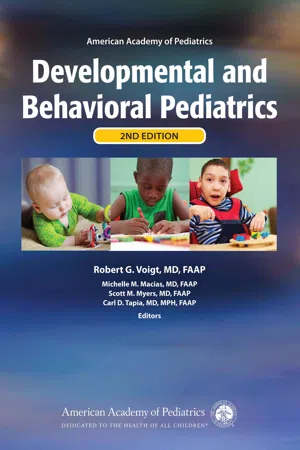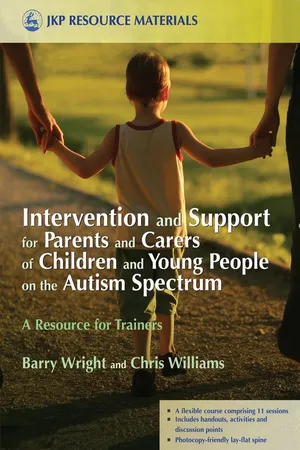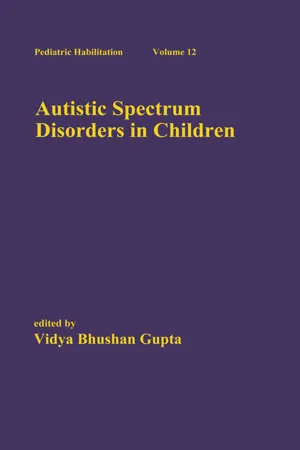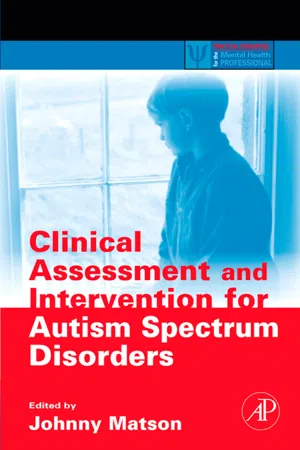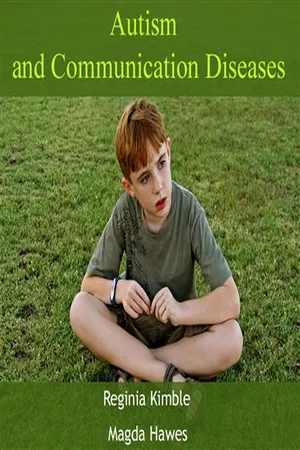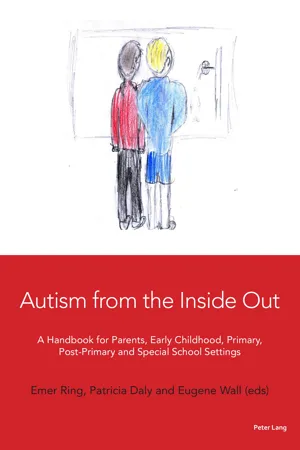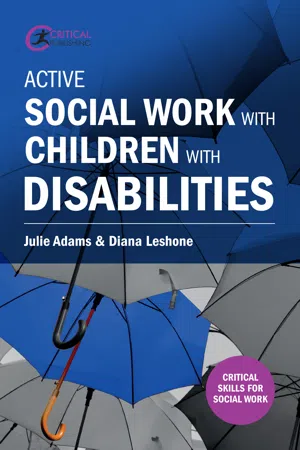Psychology
Behaviour Strategies For Autism
Behaviour strategies for autism involve using evidence-based interventions to address challenging behaviours and promote positive social interactions and communication skills in individuals with autism spectrum disorder (ASD). These strategies may include applied behaviour analysis (ABA), positive behaviour support (PBS), social skills training, and sensory integration therapy, tailored to the unique needs of each individual with ASD.
Written by Perlego with AI-assistance
Related key terms
1 of 5
10 Key excerpts on "Behaviour Strategies For Autism"
- eBook - PDF
- AAP Section on Developmental and Behavioral Pediatrics, Robert G. Voigt, Robert G. Voigt(Authors)
- 2018(Publication Date)
- American Academy of Pediatrics(Publisher)
441 Chapter 19: Autism Spectrum Disorder practices are designed to address a single or limited number of key skills or behavioral goals. 292,293,306,308 These practices are operationally defined, address specific outcomes, and are delivered over a shorter time than CTMs to achieve the specific goals. In many cases, these focused interventions are important components of the comprehensive models. A focused intervention may address a core component of ASD, such as increas-ing social communication or decreasing ritualistic behavior, or may focus on building functional, adaptive skills such as personal hygiene tasks or compliance with medical and dental procedures. Alternatively, the primary goal may be to decrease an undesired behavior such as aggression or property destruction. However, even when reduction of problem behavior is the primary goal, interventions include a skill-building component to increase appropriate alternative behaviors/skills. Some focused intervention practices, especially those appropriate for school-aged children, are provided as outpatient thera-pies delivered individually (eg, cognitive behavioral therapy [CBT]) or in groups (eg, social skills training) and have been evaluated in recent years using group design stud-ies. For example, there is strong evidence from randomized controlled trials supporting the use of CBT for anxiety symptoms in school-aged children with ASD who have aver-age to above average IQ. 291–293,303,310 The 2 predominant theoretical approaches to ASD intervention, particularly for young children, are applied behavior analysis (ABA) and developmental social-pragmatic (DSP) models. 294,306,311,312 Although there are important distinctions, some of which are outlined in Table 19.6, there is also significant overlap. Intervention models for very young children, for example, have increasingly incorporated developmental orientations and naturalistic behavioral approaches. - eBook - PDF
- Carr, James, Austin, John(Authors)
- 1010(Publication Date)
- Context Press(Publisher)
Behavioral Interventions for Children With Autism 247 Chapter 11 Behavioral Interventions for Children With Autism William D. Frea and Glenda L. Vittimberga California State University, Los Angeles Autistic disorder is a pervasive developmental disorder (PDD) that affects nearly 1 in every 1,000 births (Bryson, Clark, & Smith, 1988; Honda, Shimizu, Misumi, & Niimi, 1996; Sugiyama & Abe, 1989). The essential features of the disorder are (1) qualitative impairments in social interaction, (2) abnormal and impaired communi- cation development, and (3) restrictive, repetitive, and stereotyped patterns of behavior, interests, and activities (American Psychiatric Association, 1994). Applied behavior analysis has played the leading role in discovering and evaluating treat- ments for autistic disorder. In the early 1960s, behavioral researchers began to explore approaches to teaching children with autism that proved to be effective (Ferster, 1961; Ferster & DeMyer, 1961, 1962; Lovaas, Berberich, Perloff, & Schaeffer, 1966; Lovaas, Freitag, Gold, & Kassorla, 1965). These approaches led to a stream of validated interventions in the areas of language development, play acquisition, functional skills training, and increased social responding that continue to be built upon today. Whereas the challenges of the 1960s and 1970s were in demonstrating that children with autism could benefit from teaching, the challenges that applied behavior analysts face going into the twenty-first century are focused more on the development of assessments and interventions that are both functional and well suited for application in children’s homes, schools, and community settings (Koegel, Koegel, Frea, & Smith, 1995). This chapter will review current research and issues in the field of autism across four areas: (1) disruptive and destructive behaviors, (2) self-stimulatory behavior, (3) language development, and (4) social skills. We also present several directions for future research. - eBook - PDF
- Joanne Brayshaw, Christopher Williams(Authors)
- 2007(Publication Date)
- Jessica Kingsley Publishers(Publisher)
Introducing the theme: strategies for managing behaviour The whole of this session is devoted to teaching participants about specific strate-gies they can use with their child with an autism spectrum condition (ASC). You can choose from any of the following strategies to use in teaching this session and Session 10. (See Handouts 8.1–8.13 at the end of this session for more detail on the strategies covered.) In order to facilitate the participants in developing further strategies to use with their child with an ASC, provide short teaching sessions on specific strategies based on the expressed needs of the participants. This will vary from group to group, depending on the participants’ needs, but the following strategies are those most often requested: 185 STRATEGIES FOR MANAGING BEHAVIOUR (1) Exercise/group discussion In this session the exercise is the group discussion. It should be brought to life by the real scenarios shared by participants and facilitators. In the previous session the therapists will have worked together with families to put a strategy or strategies in place. The feedback from each participant at the beginning of this session will have allowed others to hear how particular strategies might have been suggested for paticular scenarios. You can now use this opportu-nity to develop an understanding of these strategies by contextualizing them with participants’ own scenarios. You may also use previous examples of any strategy. This allows the session to come to life, rather than being a dry teaching session. Participants should also be encouraged to describe any other strategies that they have found useful in the context of any of the scenarios being presented. Questions and answers Allow a few minutes at the end of the session for participants to put any questions they may have about problems with the strategies for managing behaviour, or about topics discussed in the previous sessions. - eBook - PDF
- Vidya Bhushan Gupta(Author)
- 2004(Publication Date)
- CRC Press(Publisher)
8 Behavioral and Educational Interventions for Young Children with Autism John M.Suozzi Children’s Hospital, Richmond, Virginia, U.S.A. I. INTRODUCTION Behavioral and educational interventions are the mainstay of management of individuals with autism (1–7). A wide array of such “treatments” is available for young children with autism. While there is empirical evidence for the efficacy and effectiveness of some of these interventions, many have gained support in the absence of empirical data to verify their effectiveness and utility. Behavioral and educational interventions, both proven and unproven, are discussed here, because the absence of a research-based demonstration of efficacy does not mean that a treatment is ineffective, only that its efficacy has not been demonstrated through objective means (8). II. BEHAVIORAL INTERVENTIONS A. Applied Behavior Analysis and Discrete Trial Training Broadly defined, the body of knowledge known as applied behavior analysis (ABA) focuses on what people say and do (behavior), and utilizes experimental analyses of environmental influences on behavior to derive techniques for behavior change. The origin of the experimental analysis of behavior is credited to B.F.Skinner (9). Based on his extensive data from observation, manipulation, and analysis of animal and human behavior, Skinner hypothesized that behavior is a function of its consequences. He believed that there are rules or laws that govern all behavior, and he developed procedures from these laws that were used to produce significant changes in a number of different types of behavior. Many years of experimental research by a number of prominent psychologists of a behavioral orientation have given credence and support to Skinner’s original theories. - Angela Williams(Author)
- 2019(Publication Date)
- Omnigraphics(Publisher)
Because there can be overlap in symptoms between ASD and other disorders, such as attention deficit hyperactivity disorder (ADHD), it’s important that treatment focus on a person’s specific needs, rather than the diagnostic label. Behavioral Management Therapy for Autism Behavior management therapy tries to reinforce wanted behaviors and reduce unwanted behaviors. It also suggests what caregivers can do before, during, after, and between episodes of problem behaviors. This chapter includes text excerpted from What Are the Treatments for Autism?” Eunice Kennedy Shriver National Institute of Child Health and Human Development (NICHD), January 31, 2017. 262 Autism and Pervasive Developmental Disorders Sourcebook, 4th Ed. Behavioral therapy is often based on applied behavior analysis (ABA), a widely accepted approach that tracks a child’s progress in improving his or her skills. Different types of ABA commonly used to treat autism spectrum disorder (ASD) include: Positive Behavioral and Support (PBS)� PBS aims to figure out why a child does a particular problem behavior. It works to change the environment, teach skills, and make other changes that make a correct behavior more positive for the child. This encourages the child to behave in a less problematic manner. Pivotal Response Training (PRT)� PRT takes place in the child s everyday environment. Its goal is to improve a few “pivotal” skills, such as motivation and taking initiative to communicate. These help the child to learn many other skills and deal with many situations. Early Intensive Behavioral Intervention (EIBI)� EIBI provides individualized behavioral instruction to very young children with ASD. It requires a large time commitment and provides one-on-one or small-group instruction. Discrete Trial Teaching (DTT)� DTT teaches skills in a controlled, step-by-step way. The teacher uses positive feedback to encourage the child to use new skills.- Johnny L. Matson(Author)
- 2011(Publication Date)
- Academic Press(Publisher)
The added complexities with an ASD population may have led the Autism Special Interest Group (2004) of the Association for Behav-ior Analysis International to recommend extra criteria for a justifiable claim for professional expertise in assessment and intervention for behavior analysts (see www.BACB.com) who specialize in ASDs. Our interpretations of the recent research reviewed for this chapter strengthen the view that the Autism SIG’s rec-ommendations should be taken seriously by professionals, services who employ them, and consumers, e.g., people with ASDs and their parents, teachers, and other carers. Two approaches to intervention for challenging behaviors have received con-siderable research effort and continue to do so: psychopharmacology and Applied Behavior Analysis. We did not review the psychopharmacology research, but we reviewed examples from the ABA research literature to illustrate the variety of interventions that may be selected depending on the functional characteristics of an individual’s challenging behavior (see section on “Behavioral Interventions Selected by Maintaining Function”). Although the efficacy of these treatments based on the science of ABA has been demonstrated in the published research, there is at present a relative lack of research on the effectiveness of the approach. An efficacious treatment is one that has been demonstrated as beneficial in carefully controlled scientific studies. An effective treatment is one that is still beneficial when used “in the wild”, i.e., in typical environments such as homes and schools when conducted by regular carers like parents and teachers (see, Chambless and Hollon, 1998). In the section “Prevalence of Biological and Behavioral Interventions”, we noted that researchers have found that a large proportion of people with chal-lenging behaviors are prescribed medications or other biological treatments for which there is insufficient evidence to describe their use as “evidence-based”.- No longer available |Learn more
- (Author)
- 2014(Publication Date)
- College Publishing House(Publisher)
________________________ WORLD TECHNOLOGIES ________________________ Chapter 9 Autism Therapies A three-year-old with autism points to fish in an aquarium, as part of an experiment on the effect of intensive shared-attention training on language development. Autism therapies attempt to lessen the deficits and family distress associated with autism and other autism spectrum disorders (ASD), and to increase the quality of life and functional independence of autistic individuals, especially children. No single treatment is best, and treatment is typically tailored to the child's needs. Treatments fall into two ________________________ WORLD TECHNOLOGIES ________________________ major categories: educational interventions and medical management. Training and support are also given to families of those with ASD. Studies of interventions have methodological problems that prevent definitive conc-lusions about efficacy. Although many psychosocial interventions have some positive evidence, suggesting that some form of treatment is preferable to no treatment, the methodological quality of systematic reviews of these studies has generally been poor, their clinical results are mostly tentative, and there is little evidence for the relative effectiveness of treatment options. Intensive, sustained special education programs and behavior therapy early in life can help children with ASD acquire self-care, social, and job skills, and often can improve functioning, and decrease symptom severity and maladaptive behaviors; claims that intervention by around age three years is crucial are not substantiated. Available approaches include applied behavior analysis (ABA), developpmental models, structured teaching, speech and language therapy, social skills therapy, and occupational therapy. - eBook - PDF
Autism from the Inside Out
A Handbook for Parents, Early Childhood, Primary, Post-Primary and Special School Settings
- Emer Ring, Patricia Daly, Eugene Wall(Authors)
- 2018(Publication Date)
Such a systematic approach to intervention monitors children’s progress efficiently and effectively, which was acknowledged in the study. Key Signposts: Applied Behaviour Analysis • Applied Behaviour Analysis is a systematic approach to observing behaviour, measuring it, analysing the target behaviour and the function that it serves. • A Functional Behaviour Assessment is central to ABA and it involves systematic analysis of the antecedents (A), or what comes before this Behaviour (B) and its reinforcer, recorded as the Consequence (C), of the B. • Specific initial and continuous professional development in such an approach. Conclusion This chapter adopts a neuropsychological theoretical framework as a coher- ent working model for the selection and application of effective teaching strategies to promote successful learning for children with ASD. The study by Daly and colleagues (2016) acknowledges that teachers’ repertoire of ASD specific teaching methodologies was excellent, and included those discussed in this chapter. It was noted that ‘classroom and school envir- onments were well-structured and students navigated the environment comfortably and confidently’ with particular attention ‘directed towards visual approaches to learning and accommodating students’ sensory dif- ferences’ (Daly et al. 2016: 10). Mainstream approaches were used instinc- tively and were ‘second nature’ to teachers’ practice. Table 1.3 outlines the critical ingredients, cited in an increasing body of international evidence 40 Margaret Egan (Attwood 2006; Boroson 2016; Morling and O’Connell 2015), in relation to effective teaching strategies to promote successful learning for all students, including those with ASD. The majority of teachers in the report cited these six approaches to intervention, as being effective teaching strategies to promote successful learning. - eBook - PDF
Autism Spectrum Disorders
From Genes to Environment
- Tim Williams(Author)
- 2011(Publication Date)
- IntechOpen(Publisher)
Each student is systematically observed for current behavioral functioning. Based on the student’s behavior repertoire, behavior excesses and deficits are identified and long-term and short-term goals are devised. Each student is taught using an individualized curriculum using positive reinforcement to encourage accurate responding. Programs and treatment plans are research- and data-based. Programs include an individualized teaching strategy. The effectiveness of teaching and treatment implementation is evaluated in an ongoing manner Applied Behavior Analysis: Teaching Procedures and Staff Training for Children with Autism 193 using specific data-collection procedures, including visual displays, such as, graphs or charts. Data collection is used to evaluate the progress of the student and the teaching professionals. In summary, ABA is critical in the education and intervention for students with autism. Some important factors in the realm of ABA as related to students with autism are as follows. There is a strong emphasis on defining problems in terms of behavior that can be operationally defined and measured. Increases or decreases in the target behavior indicate the extent to which behavior changed or improved. Teaching and treatment procedures are designed to assist each person to function more fully in society. Methods and rationales are described and defined. Socially important changes are demonstrated using scientific demonstrations that are explicated using single-subject research designs. In addition, there is a very high value placed on all those involved in the education of students with autism. 3. Applied Behavior Analysis - forms of behavior Two forms of behavior are respondent and operant behavior (Cooper et al., 2007). Respondent behavior refers to reflexive responses that are elicited by certain stimuli and over which individuals have little or no control (e.g., sneezing, blinking, or emotional responses). - No longer available |Learn more
- Julie Adams, Diana Leshone(Authors)
- 2016(Publication Date)
- Critical Publishing(Publisher)
Strategies, techniques and programmes to support In Chapter 5 we introduced you to autism, giving you a whistle-stop tour of the triad of impairments identified when working with autistic children. As you will dis-cover, when communication is impaired and the child cannot express their needs and wishes, this can result in challenging behaviours being displayed. Furthermore, when a child’s parents or carers cannot understand their communication signs and behaviours, which are often a form of communication in themselves, this can heighten 164 ACTIvE SOCIAL WORk WITH CHILDREN WITH DISABILITIES frustrations and create further negative behaviours. Most parents who are attending children’s centres, special schools or child development centres are invited to attend courses and groups to help them learn about these behaviours and how to maximise support. They also offer opportunities to find peer support from other parents who share common ground. There are also charity websites and parent forums where par-ents can feel supported and share their experiences, trials and successes with others. You won’t be expected to have all the answers and resolve parents’ dif ficulties, but you can refer and pass on any relevant information you find in your research and reading. Many children with complex learning disabilities or who are on the autistic spectrum are rigid in imagination and thoughts and not open to change. They become anxious, and need time to process change and warning of events that are going to happen or be different. They are often isolated, have a lack of empathy for other people’s feelings and have dif ficulty in processing information. Children with autism need to socialise with other children but this must be done in a more gradual way, such as play with one child then increase this to two children, then to three etc over a slow period.
Index pages curate the most relevant extracts from our library of academic textbooks. They’ve been created using an in-house natural language model (NLM), each adding context and meaning to key research topics.
